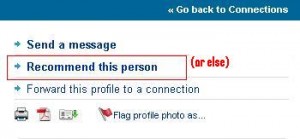Communicating layoffs has to be hard work. I’ve never done it, but even having conversations that affect the livelihood of employees one-on-one is tough enough. Recently I ran across this great article titled “The Speech I Wish CEOs Would Give [for Layoffs]” by Dale Dauten. Link to the original post is at the bottom, but this was too good not to share. After you read it you’ll see that it’s less about how to communicate layoffs and more about alternative solutions, but trust me, it’s worth your time.
——
Sure, there are situations where layoffs are inevitable, but I believe many could be avoided. Here\’s how I wish executives would think about layoffs, expressed as The Speech I Wish CEOs Would Give…
[Speaking to all employees] As you know, our sales revenues are down. I know that you must be worried – fear is a rational response when the media are full of images from the Great Depression. Indeed, everyone is expecting me to announce layoffs – stockholders and other investors want me to do something – anything — to help keep profits from declining, and layoffs are tangible evidence that a CEO is responding. However, I am announcing today that we will NOT be having layoffs anytime soon.
When companies proclaim that they are going to cut staff, here\’s what usually happens. Some of those “cuts†are merely positions that were put in the budget and have yet to be filled, so eliminating them doesn\’t actually reduce current spending, just future budgets. Next, and more importantly, the cuts tend to be among the least expensive employees, especially entry-level employees. Thus, should you succeed in reducing the headcount by 10%, you\’ve actually cut the spending on personnel by less than 5%, perhaps only two or three percent.
Further, total spending on salaries is just a fraction of overall costs; in our case, one-quarter of total expenses. So if you announce a ten percent lay-off, you reduce one-quarter of expenses by a few percentage points, meaning that you succeeded in cutting costs by one or two percent.
And what is the cost of that cost savings? You have fearful employees, hunkering down, devoting much of the internal conversation organization to worry. That\’s not what we hired you to think about.
So today, instead of announcing staff cuts, I am asking you to do join with me in doing the cutting – cutting waste out of our system. My goal is that we find ways to reduce costs by 10%. This will have a financial impact five times greater than cutting the staff by 10%. Further, I want you to find new efficiencies that allow us to take out expenses while better serving our customers. In other words, I\’m asking you to be creative, and for that I need confident, bold employees.
If we do this right, and do this together, we will become a better, faster organization. Together we can go without layoffs. Instead of worrying about who will stay and go, I invite you to join me in worrying about how we will become even more useful to each other and to our customers. Instead of getting rid of some of you, I\’m counting on all of you – now go out and prove me right.
Originally posted on Dale Dauten’s blog.


 How should employers and HR pros handle employee LinkedIn recommendation requests? I received this great question the other day, and I wanted to answer publicly because she’s definitely not the only one curious about the topic. Here we go:
How should employers and HR pros handle employee LinkedIn recommendation requests? I received this great question the other day, and I wanted to answer publicly because she’s definitely not the only one curious about the topic. Here we go: